600-ship Navy
The 600-ship Navy was a strategic plan of the United States Navy during the 1980s to rebuild its fleet after cutbacks that followed the end of the Vietnam War. The plan, which originated with Republican leaders, was an important campaign plank of Ronald Reagan in the 1980 presidential election, who advocated a larger military and strategic confrontation with the Soviet Union.
The actual number of ships peaked at 594 in 1987, before declining sharply after the end of the Cold War in 1989–1991.[1]
The program included:
- Recommissioning the Iowa-class battleships
- Keeping older ships in service longer
- A large new construction program
- Stepped up production of Nimitz-class aircraft carriers
The idea was supported by John F. Lehman, who became Reagan's Secretary of the Navy, and Caspar Weinberger, Reagan's Secretary of Defense.
Background
The idea behind the 600-ship Navy can be traced back to the Vietnam War. During the war, the armed services rapidly expanded to meet the demands placed on them.
The Soviet Union, which had been supporting North Vietnam, began staging their naval vessels from former US ports in South Vietnam. Building on this gain, Soviet vessels began to sail in all seven seas with increased vigor and even ventured into the Gulf of Mexico.[2] Soviet forces also stepped up infantry, armor and air force deployments in Eastern Europe.
Reagan plan
It was against this backdrop in 1980 that the United States began an election year. Ronald Reagan continued this in 1984, releasing a campaign commercial "Bear," which played on the use of the bear as a national symbol of Russia in order to promote higher vigilance and defense expenditures against the Soviet Union.
The overseas strategic retaliation arm was strengthened and the development of new weaponry like the B-1B bomber, the Bradley fighting vehicle, and the Abrams tank was completed and they were put into production.
Lehman attempted to "front-load" the program, by committing the Navy to the building program, but in the end the funds were not available and it fell short.[3]
Ships and weapons systems deployed during the plan
The Navy saw the largest benefit of the rebuilding. Under the Reagan Administration, the first of the Ohio-class ballistic missile submarines was completed. This class was the largest submarine ever built in the US. The ship carried 24 Trident I nuclear-capable missiles, each one with a 4,000-mile (6,400 km) range. Construction of the Nimitz class of supercarriers and Los Angeles-class attack submarines was dramatically stepped up. The revolutionary new Aegis combat system was installed on the upcoming Ticonderoga-class ships, production of which was also stepped up. Several aircraft carriers were put through Service Life Extension Programs (SLEPs) aimed at keeping them in service longer. The Iowa-class battleships, built in the 1940s, were all recommissioned and refitted with RGM-84 Harpoon, BGM-109 Tomahawk, and Phalanx CIWS system capabilities, plus their armor plating would be more resilient against anti-ship missiles. The first Harpoons, Tomahawks, and AGM-88 HARM missiles all debuted on the navy's ships. Naval aviation was stepped up with the introduction of the F/A-18 Hornet, along with improved versions of the EA-6 Prowler electronic countermeasure aircraft, the A-6 Intruder, and the F-14 Tomcat. In addition, the nation's strategic retaliatory arm was strengthened with advanced B-1B bombers and deploying Pershing II theater missiles to Europe. The initiative also included deployment of Abrams main battle tanks and Bradley armored fighting vehicles.
Build-up by year
| Class of Ships | Image | 1980 | 1981 | 1982 | 1983 | 1984 | 1985 | 1986 | 1987 | 1988 | 1989 | 1990 |
|---|---|---|---|---|---|---|---|---|---|---|---|---|
| Nimitz-class aircraft carrier | .jpg) | 2 | 2 | 3 | 3 | 3 | 3 | 4 | 4 | 4 | 5 | 5 |
| USS Enterprise (CVN-65) | _underway_in_the_Atlantic_Ocean_on_14_June_2004_(040614-N-0119G-020).jpg) | 1 | 1 | 1 | 1 | 1 | 1 | 1 | 1 | 1 | 1 | 1 |
| Kitty Hawk-class aircraft carrier | _aerial_Battle_E.jpg) | 4 | 4 | 4 | 4 | 4 | 4 | 4 | 4 | 4 | 4 | 4 |
| Forrestal-class aircraft carrier | _underway_at_sea_in_1987_(NH_97657-KN).jpg) | 4 | 4 | 4 | 4 | 4 | 4 | 4 | 4 | 4 | 4 | 4 |
| Midway-class aircraft carrier | 2 | 2 | 2 | 2 | 2 | 2 | 2 | 2 | 2 | 2 | 2 | |
| Essex-class aircraft carrier | 1 | 1 | 1 | 1 | 1 | 1 | 1 | 1 | 1 | 1 | 1 | |
| Total | Ships | 14 | 14 | 15 | 15 | 15 | 15 | 16 | 16 | 16 | 17 | 17 |
| Class of Ships | Image | 1980 | 1981 | 1982 | 1983 | 1984 | 1985 | 1986 | 1987 | 1988 | 1989 | 1990 |
|---|---|---|---|---|---|---|---|---|---|---|---|---|
| Iowa-class battleship |  | 0 | 0 | 0 | 1 | 2 | 2 | 3 | 3 | 4 | 4 | 4 |
| Total | Ships | 0 | 0 | 0 | 1 | 2 | 2 | 3 | 3 | 4 | 4 | 4 |
| Class of Ships | Image | 1980 | 1981 | 1982 | 1983 | 1984 | 1985 | 1986 | 1987 | 1988 | 1989 | 1990 |
|---|---|---|---|---|---|---|---|---|---|---|---|---|
| Ticonderoga-class cruiser | 0 | 0 | 0 | 1 | 2 | 3 | 5 | 9 | 11 | 15 | 16 | |
| Virginia-class cruiser | _elevated_starboard_view.jpg) | 4 | 4 | 4 | 4 | 4 | 4 | 4 | 4 | 4 | 4 | 4 |
| California-class cruiser | 2 | 2 | 2 | 2 | 2 | 2 | 2 | 2 | 2 | 2 | 2 | |
| USS Truxtun (CGN-35) | _underway_off_Point_Loma%2C_California_(USA)%2C_circa_in_the_1970s.jpg) | 1 | 1 | 1 | 1 | 1 | 1 | 1 | 1 | 1 | 1 | 1 |
| Belknap-class cruiser | _underway_in_the_Mediterranean_Sea_on_21_July_1992_(6480605).jpg) | 9 | 9 | 9 | 9 | 9 | 9 | 9 | 9 | 9 | 9 | 9 |
| Leahy-class cruiser | _at_sea_off_San_Diego%2C_in_May_1978.jpg) | 9 | 9 | 9 | 9 | 9 | 9 | 9 | 9 | 9 | 9 | 9 |
| Long Beach-class cruiser | _underway_at_sea%2C_circa_in_the_1960s.jpg) | 1 | 1 | 1 | 1 | 1 | 1 | 1 | 1 | 1 | 1 | 1 |
| Total | Ships | 26 | 26 | 26 | 27 | 28 | 29 | 31 | 35 | 37 | 41 | 42 |
| Class of Ships | Image | 1980 | 1981 | 1982 | 1983 | 1984 | 1985 | 1986 | 1987 | 1988 | 1989 | 1990 |
|---|---|---|---|---|---|---|---|---|---|---|---|---|
| Kidd-class destroyer | .jpg) | 0 | 3 | 4 | 4 | 4 | 4 | 4 | 4 | 4 | 4 | 4 |
| Spruance-class destroyer | .jpg) | 30 | 30 | 30 | 31 | 31 | 31 | 31 | 31 | 31 | 31 | 31 |
| Charles F. Adams-class destroyer | _underway_c1973.jpg) | 23 | 23 | 23 | 23 | 23 | 23 | 23 | 23 | 23 | 20 | 10 |
| Farragut-class destroyer (1958) | _underway_in_the_Atlantic_Ocean_on_2_July_1982_(6349812).jpg) | 10 | 10 | 10 | 10 | 10 | 10 | 10 | 10 | 10 | 8 | 7 |
| Forrest Sherman-class destroyer |  | 18 | 18 | 7 | 1 | 1 | 1 | 1 | 1 | 0 | 0 | 0 |
| Gearing-class destroyer | _underway_off_Point_Loma%2C_in_1964.jpg) | 14 | 7 | 2 | 0 | 0 | 0 | 0 | 0 | 0 | 0 | 0 |
| Total | Ships | 95 | 91 | 76 | 69 | 69 | 69 | 69 | 69 | 68 | 63 | 52 |
| Class of Ships | Image | 1980 | 1981 | 1982 | 1983 | 1984 | 1985 | 1986 | 1987 | 1988 | 1989 | 1990 |
|---|---|---|---|---|---|---|---|---|---|---|---|---|
| Oliver Hazard Perry-class frigate |  | 8 | 17 | 26 | 37 | 45 | 50 | 52 | 54 | 54 | 55 | 55 |
| Knox-class frigate | _San_Francisco.jpg) | 46 | 46 | 46 | 46 | 46 | 46 | 46 | 46 | 46 | 46 | 46 |
| Brooke-class frigate | _stbd_beam_view.jpg) | 6 | 6 | 6 | 6 | 6 | 6 | 6 | 6 | 1 | 0 | 0 |
| Garcia-class frigate | _underway_on_1_July_1986_(6421920).jpg) | 11 | 11 | 11 | 11 | 11 | 11 | 11 | 11 | 5 | 1 | 0 |
| Bronstein-class frigate | _underway_off_the_coast_of_Southern_California_(USA)_on_24_November_1986_(6449827).jpg) | 2 | 2 | 2 | 2 | 2 | 2 | 2 | 2 | 2 | 2 | 2 |
| Total | Ships | 73 | 82 | 91 | 102 | 110 | 115 | 117 | 119 | 108 | 104 | 103 |
| Years | 1980 | 1981 | 1982 | 1983 | 1984 | 1985 | 1986 | 1987 | 1988 | 1989 | 1990 |
|---|---|---|---|---|---|---|---|---|---|---|---|
| Total Major Combatants Active | 208 | 213 | 208 | 214 | 224 | 230 | 236 | 242 | 232 | 229 | 218 |
| Class of Ships | Image | 1980 | 1981 | 1982 | 1983 | 1984 | 1985 | 1986 | 1987 | 1988 | 1989 | 1990 |
|---|---|---|---|---|---|---|---|---|---|---|---|---|
| Wasp-class amphibious assault ship | .jpg) | 0 | 0 | 0 | 0 | 0 | 0 | 0 | 0 | 0 | 1 | 1 |
| Tarawa-class amphibious assault ship | 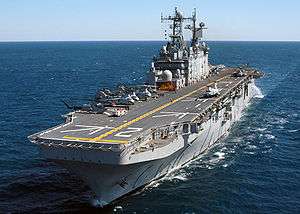 | 5 | 5 | 5 | 5 | 5 | 5 | 5 | 5 | 5 | 5 | 5 |
| Iwo Jima-class amphibious assault ship | _1979.jpg) | 7 | 7 | 7 | 7 | 7 | 7 | 7 | 7 | 7 | 7 | 7 |
| Total | Ships | 12 | 12 | 12 | 12 | 12 | 12 | 12 | 12 | 12 | 13 | 13 |
| Class of Ships | Image | 1980 | 1981 | 1982 | 1983 | 1984 | 1985 | 1986 | 1987 | 1988 | 1989 | 1990 |
|---|---|---|---|---|---|---|---|---|---|---|---|---|
| Whidbey Island-class dock landing ship | _makes_a_wide_turn_prior_to_conducting_helicopter_operations_off_the_coast_of_the_island_of_Sumatra%2C_Indonesia.jpg) | 0 | 0 | 0 | 0 | 0 | 1 | 2 | 3 | 3 | 4 | 5 |
| Anchorage-class dock landing ship | _departs_San_Diego_Bay.jpg) | 5 | 5 | 5 | 5 | 5 | 5 | 5 | 5 | 5 | 5 | 5 |
| Thomaston-class dock landing ship | 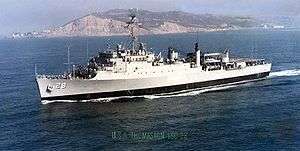 | 8 | 8 | 8 | 6 | 4 | 3 | 3 | 3 | 3 | 1 | 0 |
| Casa Grande-class dock landing ship |  | 1 | 1 | 1 | 1 | 1 | 1 | 1 | 1 | 1 | 0 | 0 |
| Total | Ships | 14 | 14 | 14 | 12 | 10 | 10 | 11 | 12 | 12 | 10 | 10 |
| Class of Ships | Image | 1980 | 1981 | 1982 | 1983 | 1984 | 1985 | 1986 | 1987 | 1988 | 1989 | 1990 |
|---|---|---|---|---|---|---|---|---|---|---|---|---|
| Austin-class amphibious transport dock | .jpg) | 12 | 12 | 12 | 12 | 12 | 12 | 12 | 12 | 12 | 12 | 12 |
| Raleigh-class amphibious transport dock | _underway%2C_circa_in_the_1970s.jpg) | 3 | 3 | 3 | 3 | 3 | 3 | 3 | 3 | 3 | 3 | 3 |
| Total | Ships | 15 | 15 | 15 | 15 | 15 | 15 | 15 | 15 | 15 | 15 | 15 |
| Class of Ships | Image | 1980 | 1981 | 1982 | 1983 | 1984 | 1985 | 1986 | 1987 | 1988 | 1989 | 1990 |
|---|---|---|---|---|---|---|---|---|---|---|---|---|
| Charleston-class amphibious cargo ship | 5 | 5 | 5 | 5 | 5 | 5 | 5 | 5 | 5 | 5 | 5 | |
| USS Tulare (AKA-112) | _underway_off_San_Francisco%2C_California_(USA)%2C_on_8_December_1955_(6931994).jpg) | 1 | 1 | 1 | 1 | 1 | 1 | 0 | 0 | 0 | 0 | 0 |
| Total | Ships | 6 | 6 | 6 | 6 | 6 | 6 | 5 | 5 | 5 | 5 | 5 |
Tank landing ship
| Class of Ships | Image | 1980 | 1981 | 1982 | 1983 | 1984 | 1985 | 1986 | 1987 | 1988 | 1989 | 1990 |
|---|---|---|---|---|---|---|---|---|---|---|---|---|
| Newport-class tank landing ship | _at_Rota_1982.jpg) | 20 | 20 | 20 | 20 | 20 | 20 | 20 | 20 | 20 | 20 | 20 |
| General Frank S. Besson-class | 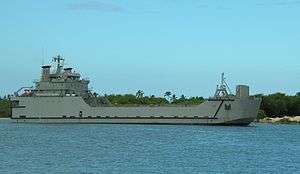 | 0 | 0 | 0 | 0 | 0 | 0 | 0 | 2 | 4 | 4 | 4 |
| Total | Ships | 20 | 20 | 20 | 20 | 20 | 20 | 20 | 22 | 24 | 24 | 24 |
| Years | 1980 | 1981 | 1982 | 1983 | 1984 | 1985 | 1986 | 1987 | 1988 | 1989 | 1990 |
|---|---|---|---|---|---|---|---|---|---|---|---|
| Total Amphibious Active | 67 | 67 | 67 | 65 | 63 | 63 | 63 | 66 | 68 | 67 | 67 |
Command Ship
| Class of Ships | Image | 1980 | 1981 | 1982 | 1983 | 1984 | 1985 | 1986 | 1987 | 1988 | 1989 | 1990 |
|---|---|---|---|---|---|---|---|---|---|---|---|---|
| Blue Ridge Class | 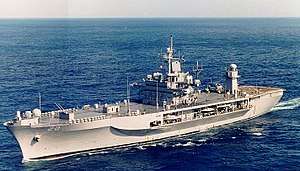 | 2 | 2 | 2 | 2 | 2 | 2 | 2 | 2 | 2 | 2 | 2 |
| Total | Ships | 2 | 2 | 2 | 2 | 2 | 2 | 2 | 2 | 2 | 2 | 2 |
| Class of Ships | Image | 1980 | 1981 | 1982 | 1983 | 1984 | 1985 | 1986 | 1987 | 1988 | 1989 | 1990 |
|---|---|---|---|---|---|---|---|---|---|---|---|---|
| Mercy-class hospital ship | _in_Hati.jpg) | 0 | 0 | 0 | 0 | 0 | 0 | 1 | 2 | 2 | 2 | 2 |
| Total | Ships | 0 | 0 | 0 | 0 | 0 | 0 | 1 | 2 | 2 | 2 | 2 |
| Class of Ships | Image | 1980 | 1981 | 1982 | 1983 | 1984 | 1985 | 1986 | 1987 | 1988 | 1989 | 1990 |
|---|---|---|---|---|---|---|---|---|---|---|---|---|
| Avenger-class mine countermeasures ship | 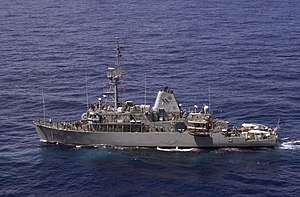 | 0 | 0 | 0 | 0 | 0 | 0 | 0 | 1 | 1 | 3 | 3 |
| Aggressive-class minesweeper | .jpg) | 19 | 19 | 19 | 19 | 19 | 19 | 19 | 19 | 19 | 18 | 14 |
| Total | Ships | 19 | 19 | 19 | 19 | 19 | 19 | 19 | 20 | 20 | 21 | 17 |
Patrol ships
| Class of Ships | Image | 1980 | 1981 | 1982 | 1983 | 1984 | 1985 | 1986 | 1987 | 1988 | 1989 | 1990 |
|---|---|---|---|---|---|---|---|---|---|---|---|---|
| Pegasus-class hydrofoil | 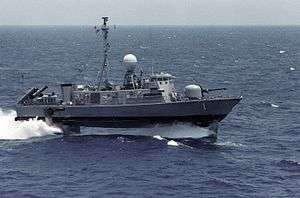 | 1 | 1 | 2 | 6 | 6 | 6 | 6 | 6 | 6 | 6 | 6 |
| Asheville-class | _mail_transfer.jpg) | 9 | 9 | 9 | 9 | 6 | 6 | 6 | 4 | 4 | 4 | 4 |
| Total | Ships | 10 | 10 | 11 | 15 | 12 | 12 | 12 | 10 | 10 | 10 | 10 |
| Class of Ships | Image | 1980 | 1981 | 1982 | 1983 | 1984 | 1985 | 1986 | 1987 | 1988 | 1989 | 1990 |
|---|---|---|---|---|---|---|---|---|---|---|---|---|
| Henry J. Kaiser-class oiler | 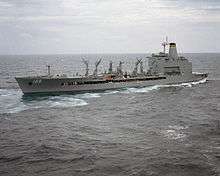 | 0 | 0 | 0 | 0 | 0 | 0 | 1 | 4 | 6 | 8 | 9 |
| Cimarron-class fleet replenishment oiler | _off_Apra_Harbor_pt_1983.jpeg) | 0 | 3 | 4 | 5 | 5 | 5 | 5 | 5 | 5 | 5 | 5 |
| Wichita-class replenishment oiler | _underway_in_the_Indian_Ocean_on_3_December_1985_(6419167).jpg) | 7 | 7 | 7 | 7 | 7 | 7 | 7 | 7 | 7 | 7 | 7 |
| Total | Ships | 7 | 10 | 11 | 12 | 12 | 12 | 13 | 16 | 18 | 20 | 21 |
| Class of Ships | Image | 1980 | 1981 | 1982 | 1983 | 1984 | 1985 | 1986 | 1987 | 1988 | 1989 | 1990 |
|---|---|---|---|---|---|---|---|---|---|---|---|---|
| USNS Lawrence H. Gianella (T-AOT-1125) | 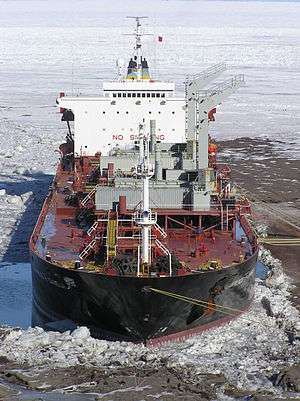 | 0 | 0 | 0 | 0 | 0 | 0 | 1 | 1 | 1 | 1 | 1 |
| SS Class | .jpg) | 1 | 2 | 2 | 2 | 2 | 2 | 2 | 3 | 3 | 3 | 3 |
| Total | Ships | 1 | 2 | 2 | 2 | 2 | 2 | 3 | 4 | 4 | 4 | 4 |
| Class of Ships | Image | 1980 | 1981 | 1982 | 1983 | 1984 | 1985 | 1986 | 1987 | 1988 | 1989 | 1990 |
|---|---|---|---|---|---|---|---|---|---|---|---|---|
| Kilauea-class ammunition ship | 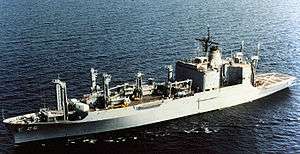 | 8 | 8 | 8 | 8 | 8 | 8 | 8 | 8 | 8 | 8 | 8 |
| Nitro-class ammunition ship | 3 | 3 | 3 | 3 | 3 | 3 | 3 | 3 | 3 | 3 | 3 | |
| Total | Ships | 11 | 11 | 11 | 11 | 11 | 11 | 11 | 11 | 11 | 11 | 11 |
| Class of Ships | Image | 1980 | 1981 | 1982 | 1983 | 1984 | 1985 | 1986 | 1987 | 1988 | 1989 | 1990 |
|---|---|---|---|---|---|---|---|---|---|---|---|---|
| Mars-class combat stores ship |  | 7 | 7 | 7 | 7 | 7 | 7 | 7 | 7 | 7 | 7 | 7 |
| Sirius class combat stores ship | -01.jpg) | 0 | 2 | 2 | 3 | 3 | 3 | 3 | 3 | 3 | 3 | 3 |
| Total | Ships | 7 | 9 | 9 | 10 | 10 | 10 | 10 | 10 | 10 | 10 | 10 |
Fast combat support ships
| Class of Ships | Image | 1980 | 1981 | 1982 | 1983 | 1984 | 1985 | 1986 | 1987 | 1988 | 1989 | 1990 |
|---|---|---|---|---|---|---|---|---|---|---|---|---|
| Sacramento-class fast combat support ship | 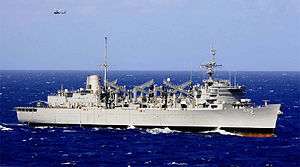 | 4 | 4 | 4 | 4 | 4 | 4 | 4 | 4 | 4 | 4 | 4 |
| Total | Ships | 4 | 4 | 4 | 4 | 4 | 4 | 4 | 4 | 4 | 4 | 4 |
| Class of Ships | Image | 1980 | 1981 | 1982 | 1983 | 1984 | 1985 | 1986 | 1987 | 1988 | 1989 | 1990 |
|---|---|---|---|---|---|---|---|---|---|---|---|---|
| Algol-class vehicle cargo ship | 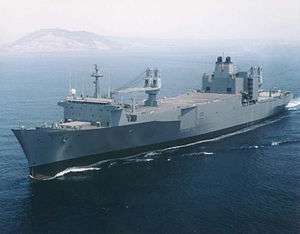 | 0 | 0 | 0 | 0 | 8 | 8 | 8 | 8 | 8 | 8 | 8 |
| Cape Island Class | 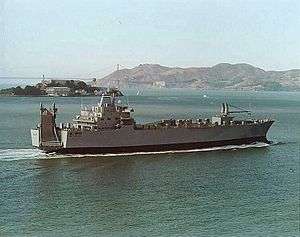 | 4 | 4 | 4 | 4 | 4 | 4 | 4 | 4 | 4 | 4 | 4 |
| Cape Ducato-class vehicle cargo ship | 0 | 0 | 0 | 0 | 0 | 5 | 5 | 5 | 5 | 5 | 5 | |
| Cape Ducato-class vehicle cargo ship | 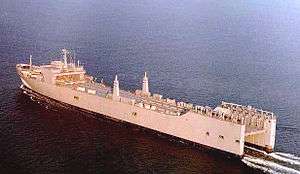 | 0 | 0 | 0 | 0 | 0 | 0 | 3 | 3 | 3 | 3 | 3 |
| Total | Ships | 7 | 9 | 9 | 10 | 10 | 10 | 10 | 10 | 10 | 10 | 10 |
| Class of Ships | Image | 1980 | 1981 | 1982 | 1983 | 1984 | 1985 | 1986 | 1987 | 1988 | 1989 | 1990 |
|---|---|---|---|---|---|---|---|---|---|---|---|---|
| Yellowstone-class destroyer tender | _underway_on_15_February_1984_(6391384).jpg) | 1 | 2 | 3 | 4 | 4 | 4 | 4 | 4 | 4 | 4 | 4 |
| Samuel Gompers-class destroyer tender | _entering_Hampton_Roads_on_20_August_1995_(6491239).jpg) | 2 | 2 | 2 | 2 | 2 | 2 | 2 | 2 | 2 | 2 | 2 |
| Shenandoah-class destroyer tender | 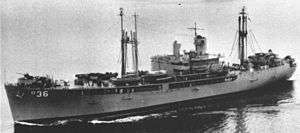 | 1 | 1 | 0 | 0 | 0 | 0 | 0 | 0 | 0 | 0 | 0 |
| Total | Ships | 4 | 5 | 5 | 6 | 6 | 6 | 6 | 6 | 6 | 6 | 6 |
| Class of Ships | Image | 1980 | 1981 | 1982 | 1983 | 1984 | 1985 | 1986 | 1987 | 1988 | 1989 | 1990 |
|---|---|---|---|---|---|---|---|---|---|---|---|---|
| Emory S. Land-class submarine tender | _underway_at_sea%2C_circa_in_the_1980s.jpg) | 2 | 3 | 3 | 3 | 3 | 3 | 3 | 3 | 3 | 3 | 3 |
| USS L. Y. Spear (AS-36) | 1 | 1 | 1 | 1 | 1 | 1 | 1 | 1 | 1 | 1 | 1 | |
| Total | Ships | 3 | 4 | 4 | 4 | 4 | 4 | 4 | 4 | 4 | 4 | 4 |
| Class of Ships | Image | 1980 | 1981 | 1982 | 1983 | 1984 | 1985 | 1986 | 1987 | 1988 | 1989 | 1990 |
|---|---|---|---|---|---|---|---|---|---|---|---|---|
| Keystone State-class crane ship | 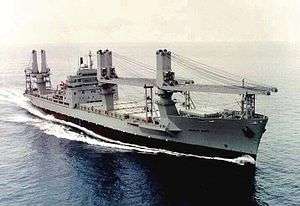 | 0 | 0 | 0 | 0 | 2 | 2 | 3 | 5 | 5 | 7 | 7 |
| Gopher State-class crane ship | 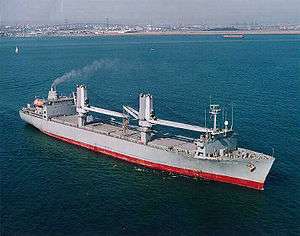 | 1 | 1 | 1 | 1 | 2 | 2 | 3 | 3 | 3 | 3 | 3 |
| Total | Ships | 1 | 1 | 1 | 1 | 4 | 4 | 6 | 8 | 8 | 10 | 10 |
| Class of Ships | Image | 1980 | 1981 | 1982 | 1983 | 1984 | 1985 | 1986 | 1987 | 1988 | 1989 | 1990 |
|---|---|---|---|---|---|---|---|---|---|---|---|---|
| American Cormorant | 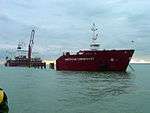 | 0 | 0 | 0 | 0 | 0 | 1 | 1 | 1 | 1 | 1 | 1 |
| Total | Ships | 0 | 0 | 0 | 0 | 0 | 1 | 1 | 1 | 1 | 1 | 1 |
Cable ship
| Class of Ships | Image | 1980 | 1981 | 1982 | 1983 | 1984 | 1985 | 1986 | 1987 | 1988 | 1989 | 1990 |
|---|---|---|---|---|---|---|---|---|---|---|---|---|
| USNS Zeus (T-ARC-7) | 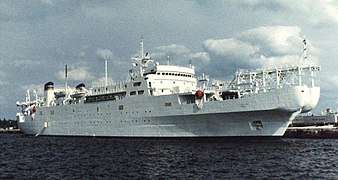 | 0 | 0 | 0 | 0 | 1 | 1 | 1 | 1 | 1 | 1 | 1 |
| Total | Ships | 0 | 0 | 0 | 0 | 1 | 1 | 1 | 1 | 1 | 1 | 1 |
| Class of Ships | Image | 1980 | 1981 | 1982 | 1983 | 1984 | 1985 | 1986 | 1987 | 1988 | 1989 | 1990 |
|---|---|---|---|---|---|---|---|---|---|---|---|---|
| Safeguard Class | 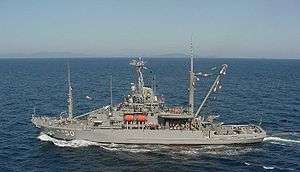 | 0 | 0 | 0 | 1 | 1 | 2 | 4 | 4 | 4 | 4 | 4 |
| Pigeon Class | .jpg) | 2 | 2 | 2 | 2 | 2 | 2 | 2 | 2 | 2 | 2 | 2 |
| Bolster-class | _underway_on_1_November_1983_(6430328).jpg) | 6 | 6 | 6 | 6 | 6 | 6 | 6 | 6 | 6 | 6 | 6 |
| Total | Ships | 8 | 8 | 8 | 9 | 9 | 10 | 12 | 12 | 12 | 12 | 12 |
| Class of Ships | Image | 1980 | 1981 | 1982 | 1983 | 1984 | 1985 | 1986 | 1987 | 1988 | 1989 | 1990 |
|---|---|---|---|---|---|---|---|---|---|---|---|---|
| USNS Observation Island (T-AGM-23) | .jpg) | 1 | 1 | 1 | 1 | 1 | 1 | 1 | 1 | 1 | 1 | 1 |
| USS Range Sentinel (AGM-22) | 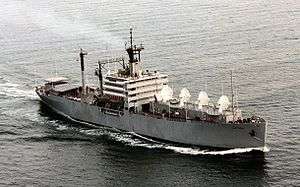 | 1 | 1 | 1 | 1 | 1 | 1 | 1 | 1 | 1 | 1 | 1 |
| USNS Vanguard (T-AG-194) | 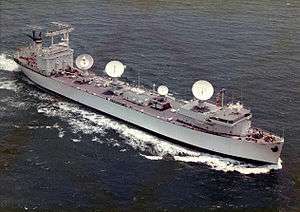 | 1 | 1 | 1 | 1 | 1 | 1 | 1 | 1 | 1 | 1 | 1 |
| Total | Ships | 3 | 3 | 3 | 3 | 3 | 3 | 3 | 3 | 3 | 3 | 3 |
Ocean surveillance ship
| Class of Ships | Image | 1980 | 1981 | 1982 | 1983 | 1984 | 1985 | 1986 | 1987 | 1988 | 1989 | 1990 |
|---|---|---|---|---|---|---|---|---|---|---|---|---|
| Stalwart-class ocean surveillance ship | 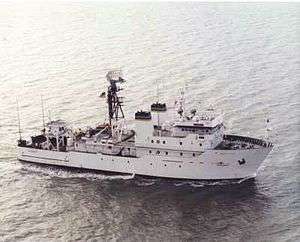 | 0 | 0 | 0 | 0 | 3 | 7 | 9 | 11 | 13 | 17 | 18 |
| Total | Ships | 0 | 0 | 0 | 0 | 3 | 7 | 9 | 11 | 13 | 17 | 18 |
| Class of Ships | Image | 1980 | 1981 | 1982 | 1983 | 1984 | 1985 | 1986 | 1987 | 1988 | 1989 | 1990 |
|---|---|---|---|---|---|---|---|---|---|---|---|---|
| USNS Hayes (T-AGOR-16) | .jpg) | 1 | 1 | 1 | 1 | 1 | 1 | 1 | 1 | 1 | 1 | 1 |
| Total | Ships | 1 | 1 | 1 | 1 | 1 | 1 | 1 | 1 | 1 | 1 | 1 |
| Years | 1980 | 1981 | 1982 | 1983 | 1984 | 1985 | 1986 | 1987 | 1988 | 1989 | 1990 |
|---|---|---|---|---|---|---|---|---|---|---|---|
| Total Auxiliary Active | 0 | 0 | 0 | 0 | 0 | 0 | 0 | 0 | 0 | 0 | 0 |
| Years | 1980 | 1981 | 1982 | 1983 | 1984 | 1985 | 1986 | 1987 | 1988 | 1989 | 1990 |
|---|---|---|---|---|---|---|---|---|---|---|---|
| Total Surface Active | 0 | 0 | 0 | 0 | 0 | 0 | 0 | 0 | 0 | 0 | 0 |
| Class of Ships | Image | 1980 | 1981 | 1982 | 1983 | 1984 | 1985 | 1986 | 1987 | 1988 | 1989 | 1990 |
|---|---|---|---|---|---|---|---|---|---|---|---|---|
| Los Angeles-class submarine | 2.jpg) | 10 | 16 | 20 | 25 | 29 | 33 | 35 | 37 | 39 | 42 | 44 |
| Sturgeon-class submarine | _underway_off_San_Diego_on_1_February_1991_(6467986).jpg) | 37 | 37 | 37 | 37 | 37 | 37 | 37 | 37 | 37 | 37 | 37 |
| Permit-class submarine | 13 | 13 | 13 | 13 | 13 | 13 | 13 | 13 | 12 | 10 | 8 | |
| Skipjack-class submarine | 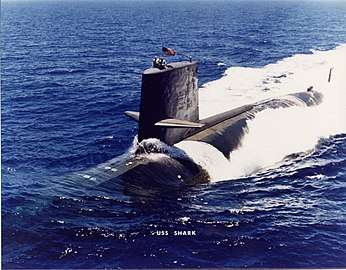 | 5 | 5 | 5 | 5 | 5 | 5 | 4 | 4 | 3 | 3 | 0 |
| Barbel-class submarine | 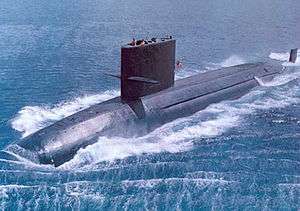 | 3 | 3 | 3 | 3 | 3 | 3 | 3 | 3 | 2 | 1 | 0 |
| Skate-class submarine | 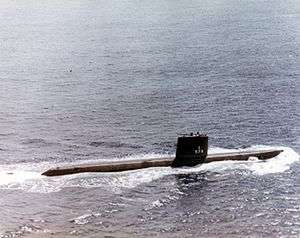 | 4 | 4 | 4 | 4 | 3 | 3 | 2 | 2 | 1 | 0 | 0 |
| USS Seawolf (SSN-575) | .jpg) | 1 | 1 | 1 | 1 | 1 | 1 | 0 | 0 | 0 | 0 | 0 |
| USS Darter (SS-576) | .jpg) | 1 | 1 | 1 | 1 | 1 | 1 | 1 | 1 | 1 | 1 | 0 |
| Tang-class submarine | 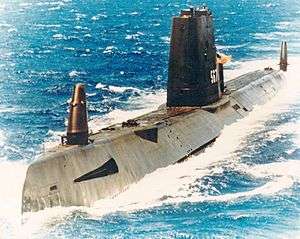 | 3 | 3 | 3 | 2 | 2 | 2 | 1 | 0 | 0 | 0 | 0 |
| Total | Subs | 77 | 83 | 87 | 91 | 94 | 98 | 96 | 97 | 95 | 94 | 89 |
| Class of Ships | Image | 1980 | 1981 | 1982 | 1983 | 1984 | 1985 | 1986 | 1987 | 1988 | 1989 | 1990 |
|---|---|---|---|---|---|---|---|---|---|---|---|---|
| Ohio-class submarine | .jpg) | 0 | 1 | 2 | 3 | 5 | 6 | 8 | 8 | 9 | 10 | 11 |
| Benjamin Franklin-class submarine |  | 12 | 12 | 12 | 12 | 12 | 12 | 12 | 12 | 12 | 12 | 12 |
| James Madison-class submarine |  | 10 | 10 | 10 | 10 | 10 | 10 | 9 | 9 | 9 | 8 | 8 |
| Lafayette-class submarine | 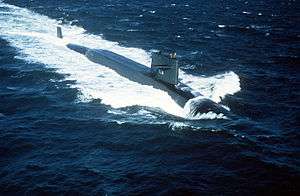 | 9 | 9 | 9 | 9 | 9 | 9 | 8 | 8 | 8 | 6 | 3 |
| Ethan Allen-class submarine | 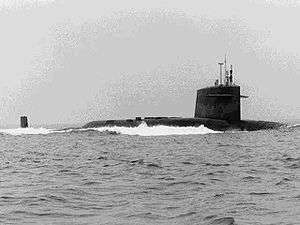 | 5 | 5 | 5 | 3 | 3 | 2 | 2 | 2 | 2 | 2 | 2 |
| George Washington-class submarine | _underway_at_sea%2C_circa_in_the_1970s.jpg) | 5 | 4 | 3 | 2 | 1 | 0 | 0 | 0 | 0 | 0 | 0 |
| Total | Subs | 41 | 41 | 41 | 39 | 40 | 39 | 39 | 39 | 40 | 38 | 36 |
| Years | 1980 | 1981 | 1982 | 1983 | 1984 | 1985 | 1986 | 1987 | 1988 | 1989 | 1990 |
|---|---|---|---|---|---|---|---|---|---|---|---|
| Total Submarines Active | 118 | 124 | 128 | 130 | 134 | 137 | 135 | 136 | 135 | 132 | 125 |
End of the plan
Eventually political pressure to reduce the national budget deficit resulted in Congress reversing itself and passing a series of declining defense budgets beginning in 1986. Weinberger clashed with Congress over the cuts, resigning in late 1987, and was succeeded by Frank Carlucci.[4] Lehman's successor as Navy Secretary, Jim Webb, remained a fierce proponent of the expanded fleet, and disagreed with Carlucci over how to cut the Navy budget in line with other services. Webb resigned rather than endorse Carlucci's cut of 16 frigates.[5] As revealed in The Reagan Diaries, Reagan reflected about Webb's resignation on 22 February 1988: "Present Sec. Webb resigned over budget cuts. I don't think Navy was sorry to see him go."
Following the dissolution of the Soviet Union in the early 1990s and the lack of a perceived threat against the United States, several of the Reagan Administration's policies and plans, such as the "600-ship Navy", were scaled back or abandoned. US bases across Europe and North America were slowly decommissioned and closed, others were mothballed through the Base Realignment and Closure process. In the Navy, this resulted in the retirement of several older carriers, the decommissioning of all four of the Iowa-class battleships and the cancellation of the remaining Seawolf-class submarines.
See also
References
- Holland, W. J. (2000). The Navy. Naval Historical Foundation. ISBN 0-7607-6218-X.
- "US Ship Force Levels 1886-present". Naval History and Heritage Command. Retrieved 2 November 2016.
- "Soviet Naval Vessels Found in Gulf of Mexico". The New York Times. Associated Press. 5 October 1981. Retrieved 2006-08-31.
- Spinney, Chuck (6 December 2012). "Business As Usual Inside Obama's Pentagon". Time. Retrieved 2012-12-06.
- Church, George J. (20 June 1988). "Bringing The Pentagon to Heel". Time. Retrieved 2007-03-20.(subscription required)
- "The Navy: The Secretary Jumps Ship". Time. 7 March 1988. Retrieved 2007-03-20.(subscription required)
Further reading
- NSC-NSDD-32: U.S. National Security Strategy – The White House, May 20, 1982. archive listings
- Congressional Budget Office:
- GlobalSecurity.org
- Naval Historical Center:
- Naval War College:
- John B. Hattendorf. "The Evolution of the U.S. Navy's Maritime Strategy, 1977–1986" Naval War College Newport Paper 19 (2004), ISBN 1-884733-32-8. Available in PDF format here and here
- United States Naval Institute:
- Lieutenant General Bernard E. Trainor, U.S. Marine Corps (Retired). "Triumph in Strategic Thinking". United States Naval Institute Proceedings Vol. 134, No. 2 (February 2008) pp. 40–42
- Norman Friedman. "The Navy, the Cold War – and Now" United States Naval Institute Proceedings Vol. 133, No. 10 (October 2007) pp. 58–62
